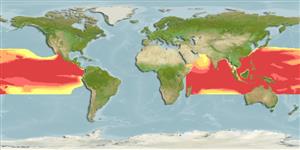Teleostei (teleosts) >
Beloniformes (Needle fishes) >
Exocoetidae (Flyingfishes)
Etymology: Cypselurus: Greek, kypselos, ou = swift + Greek,oura = tail (Ref. 45335).
More on authors: Nichols & Breder.
Environment: milieu / climate zone / depth range / distribution range
Ecology
Marine; pelagic-oceanic; oceanodromous (Ref. 51243); depth range 0 - 20 m (Ref. 27313). Tropical; 34°N - 23°S, 43°E - 79°W
Indo-Pacific: East Africa to Hawaii and the Tuamoto Islands. Probably absent from the inland seas of southeast Asia. Eastern Pacific: isolated population at Soccoro Islands, Mexico, including Revillagigedo Islands.
Size / Weight / Age
Maturity: Lm ? range ? - ? cm
Max length : 24.0 cm SL male/unsexed; (Ref. 9839)
Dorsal soft rays (total): 13; Anal soft rays: 8 - 9. Pectoral fins almost uniformly grayish, varying in tone but neither hyaline nor blackish, with a narrow pale posterior edge broadening at the tip and toward the axil of the fin. Predorsal scales 28-30. Ventral origin equidistant from about or behind the middle of opercle and base of caudal. Head narrow and pointed for this genus, the snout equal to or slightly longer than eye. Teeth tricuspid. Interobital slightly concave; eye slightly infralateral.
Coloration: Dark above to below midline of side, pale below; dorsal very pale grayish; anal white; caudal uniform dusky; ventrals pale becoming slightly dusky in the center of their base.
Epipelagic in coastal and oceanic waters. Often near oceanic islands. May leap out of the water and glide over considerable distances above the surface. Also caught using dipnet and light method (Ref. 9839).
Life cycle and mating behavior
Maturity | Reproduction | Spawning | Eggs | Fecundity | Larvae
Nichols, J.T. and C.M. Breder Jr., 1935. New Pacific flying-fishes collected by Templeton Crocker. Am. Mus. Novit. 821:1-4. (Ref. 98576)
IUCN Red List Status (Ref. 130435: Version 2024-1)
Threat to humans
Harmless
Human uses
Fisheries: minor commercial
Tools
Special reports
Download XML
Internet sources
Estimates based on models
Preferred temperature (Ref.
123201): 24.4 - 29.3, mean 27.7 °C (based on 32228 cells).
Phylogenetic diversity index (Ref.
82804): PD
50 = 0.5002 [Uniqueness, from 0.5 = low to 2.0 = high].
Bayesian length-weight: a=0.00631 (0.00288 - 0.01384), b=3.05 (2.85 - 3.25), in cm total length, based on LWR estimates for this (Sub)family-body shape (Ref.
93245).
Trophic level (Ref.
69278): 4.0 ±0.6 se; based on size and trophs of closest relatives
Resilience (Ref.
120179): High, minimum population doubling time less than 15 months (Preliminary K or Fecundity.).
Fishing Vulnerability (Ref.
59153): Low vulnerability (19 of 100).
